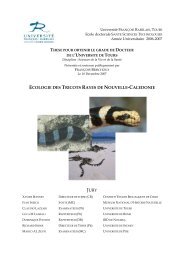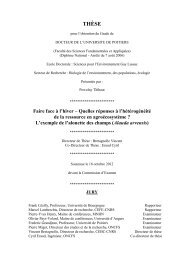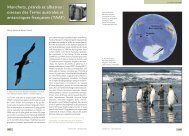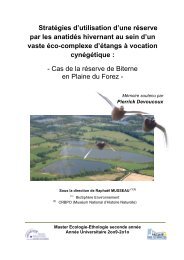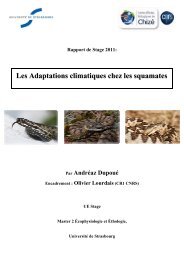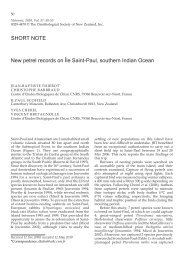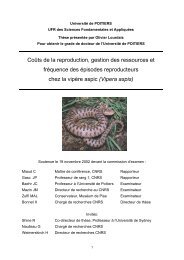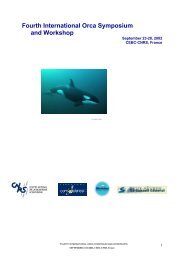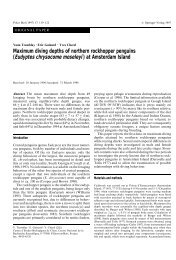Forçage environnemental et prédateurs marins ... - Cebc - CNRS
Forçage environnemental et prédateurs marins ... - Cebc - CNRS
Forçage environnemental et prédateurs marins ... - Cebc - CNRS
Create successful ePaper yourself
Turn your PDF publications into a flip-book with our unique Google optimized e-Paper software.
March 2005 COSTS OF REPRODUCTION IN BLUE PETRELS<br />
689<br />
TABLE 3. Estimation of the slope of the relationship b<strong>et</strong>ween variation in sea surface height<br />
(SSH) and annual survival in Blue P<strong>et</strong>rels at Kerguelen Islands.<br />
Breeding state Slope 1 SE 95% CI<br />
Inexperienced nonbreeders 0.0159 0.0049 0.0255, 0.0062<br />
First-time breeders 0.0256 0.0074 0.0401, 0.0111<br />
Experienced breeders 0.0002 0.0081 0.0156, 0.0160<br />
Experienced nonbreeders 0.0091 0.0071 0.0294, 0.0047<br />
Note: Estimates are from model (S r , p 14, rs<br />
SSH t t).<br />
(QAICc 10.104). For first-time breeders and inexperienced<br />
nonbreeders, the slope of the relationship<br />
was negative, with 95% confidence intervals excluding<br />
zero (Table 3). The tended to be higher for firsttime<br />
breeders (although the confidence intervals<br />
showed some overlap), perhaps indicating that they<br />
might be more sensitive to variations in SSH than<br />
nonbreeders. For experienced individuals, the value of<br />
was close to zero (Table 3), indicating that the effect<br />
of SSH on the survival probabilities was null or very<br />
low; SSH explained 58.5% of the variation in survival<br />
over time for all breeding states, and 88.2% of the<br />
temporal variation in survival for first-time breeders<br />
and inexperienced breeders.<br />
Mean body mass varied with experience, breeding<br />
state, and year (all P’s 0.001; Appendix A). Among<br />
breeders and nonbreeders, experienced individuals had<br />
higher body mass than inexperienced ones (Appendix<br />
B). The pattern of variation of body mass across years<br />
differed b<strong>et</strong>ween breeding states (significant interaction,<br />
year state; Appendix A). However, a model in<br />
which survival was a function of body mass (Table 1;<br />
[ Sr, p14, rs r<br />
]) was not preferred over model ( S ,<br />
mass t t SSH<br />
p14 t<br />
rs<br />
t<br />
, ). For each state, the 95% confidence intervals<br />
for the slopes of the relationships b<strong>et</strong>ween survival and<br />
body mass included zero. This suggested that body<br />
mass during breeding did not affect survival estimated<br />
during the following year. A model with an additive<br />
effect of SSH and body mass on survival ( Sr SSHmass,<br />
p14, rs ) was not preferred over model ( r , 14, rs<br />
t t SSSH ptt). Using model ( Sr, 14, rs<br />
SSH ptt), we tested for an effect<br />
of SSH ( Sr, 14, rs ) and body mass ( r , 14<br />
SSH pt SSH SSSH pt,<br />
rs mass)<br />
on state transition probabilities. Both models<br />
were clearly rejected (wi 0.0001; Table 1).<br />
DISCUSSION<br />
Experience had a significant, positive influence on<br />
survival and future breeding probabilities for both<br />
breeding and nonbreeding birds, confirming our first<br />
hypothesis. This result is consistent with previous findings<br />
on the Blue P<strong>et</strong>rel (Chastel <strong>et</strong> al. 1995a) and other<br />
long-lived species (see a review in Cam and Monnat<br />
[2000], Ainley [2002]) for which inexperienced breeders<br />
had a lower future probability of breeding than<br />
experienced breeders. First-time breeders had a lower<br />
survival probability than experienced breeders, which<br />
is also consistent with several other studies (Promislow<br />
1991, Clutton-Brock <strong>et</strong> al. 1996, Cam and Monnat<br />
2000). Among nonbreeders, survival probability did<br />
not seem to be affected by experience. In addition, we<br />
showed that, independently of the costs associated to<br />
reproduction, experience per se affected the life history<br />
of individuals, because inexperienced nonbreeders had<br />
lower future breeding probabilities than experienced<br />
nonbreeders.<br />
For experienced individuals, we found evidence of<br />
positive phenotypic correlations b<strong>et</strong>ween the components<br />
of fitness: breeders in year t showed a higher<br />
probability of surviving and breeding in year t 1 than<br />
nonbreeders in year t. Positive covariation among life<br />
history traits is a common phenomenon in iteroparous<br />
animals (see a review in Cam <strong>et</strong> al. [1998], Sandercock<br />
<strong>et</strong> al. [2000], Yoccoz <strong>et</strong> al. [2002]). Positive phenotypic<br />
correlations b<strong>et</strong>ween components of fitness may be<br />
caused by variation in resource availability across environments<br />
(individuals in b<strong>et</strong>ter environments should<br />
exhibit higher reproductive and survival rates than individuals<br />
in poorer environments) or variations in individual<br />
quality. Because fitness param<strong>et</strong>ers were estimated<br />
from only one colony where both breeders and<br />
nonbreeders were observable, and because birds, regardless<br />
of their status and experience, were exposed<br />
to the same environmental conditions, we suspect that<br />
positive correlations were more likely linked to differences<br />
in individual quality. In Blue P<strong>et</strong>rels, body<br />
condition may reflect individual quality because there<br />
is a positive correlation b<strong>et</strong>ween reproductive performance<br />
and body condition (Chastel <strong>et</strong> al. 1995b). Thus,<br />
our findings support the prediction of Nur’s (1988)<br />
model regarding the question of breeding vs. not breeding.<br />
By contrast, for inexperienced individuals, we found<br />
evidence of negative phenotypic correlations: first-time<br />
breeders showed a lower probability of surviving than<br />
inexperienced nonbreeders, particularly during the<br />
years 1996, 1997, and 1999. This was particularly<br />
marked in 1996, with an exceptionally low survival<br />
probability (0.628 0.068, mean 1 SE) for such a<br />
long-lived species. This result strongly supports the<br />
hypothesis of a reproductive cost on survival for inexperienced<br />
individuals. Nevertheless, first-time breeders<br />
in year t showed a higher probability of breeding<br />
in year t 1 than inexperienced nonbreeders in year<br />
t. Given that we observed a reproductive cost on survival,<br />
one may expect a reproductive cost on future<br />
breeding probability. This paradox is resolved within



